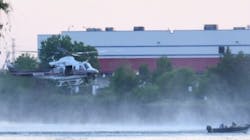NIOSH: Air Management among Factors in Chicago Diver LODD
Air management and buoyancy control were some of the contributing factors in the 2018 death of a Chicago firefighter/SCUBA diver, according to a federal line-of-duty death report.
The findings are part of a National Institute for Occupational Health and Safety (NIOSH) report released late last month. The investigation looked at the drowning of firefighter Juan J. Bucio, 46, while searching for a civilian who fell off a boat and into the South Branch of the Chicago River on May 28, 2018.
Bucio was one of two divers who was deployed by a department helicopter just before 8 p.m., according to the NIOSH report. The divers made two dives, and during the second dive, a supervisor asked for an air check.
Following the air check, both divers were told to finish their search pattern and surface. A department fast boat was deployed with relief divers and instructed to pick up the two divers in the water.
As the divers surfaced, it appeared that Bucio was having trouble maintaining positive buoyancy and needed assistance from his colleague. A nearby police boat tossed the divers a life ring, but the fast boat told the divers to head to the fire department vessel, which caused the police boat to move away.
As the divers drifted in a circular pattern toward the bow of the fast boat, Bucio pulled off his fellow diver's mask at the same time the diver grabbed the boat. Bucio's partner then inflated his buoyancy compensating device, and Bucio disappeared under the water.
Divers from the police and fast boat jumped in the river, and the fire department deployed its rapid intervention team divers. Bucio was found by a police diver after nearly 10 minutes, and he was brought aboard the police boat.
Paramedics onshore performed advanced life support measures, and Bucio was taken to the hospital, where he was pronounced dead.
In its report, NIOSH listed the following factors in Bucio's death:
- Air management
- Fundamental SCUBA skills
- Natural gas line explosion
- Buoyancy control (inability to maintain positive buoyancy)
- Members unaware of distress
- Multiple agency integration and cooperation
The agency also provided key recommendations:
- Fire departments and public safety dive agencies should provide regular training on fundamental dive skills, such as air management, buoyancy control, redundant air and out-of-air procedures
- Incident commanders, dive group leaders and members need to maintain situational awareness, accountability and frequent and accurate air status on all divers
- All public safety divers should use dive computers
- Heads-up displays in all full face SCUBA masks should be considered because of frequent zero-visibility/silt-out conditions.
- A properly trained dive safety officer is on scene and integrated into the command structure
- Public safety SCUBA diving should be seen as a high-risk/low-frequency event, and agencies should ensure that public safety divers are properly trained, equipped and supported to perform dives; training and standard operating procedures/standard operating guidelines (SOPs/SOGs) should include the regional dive and water rescue team(s) who regularly respond with interagency cooperation
- Helicopter standard operating procedures/standard operating guidelines should address diver-in-distress situations when divers are deployed before the arrival of shore and marine units
- Communications equipment should be reliable and have interoperability
- Standards-setting organizations should consider developing and adopting national consensus standards for Public Safety Diver (PSD) and equipment that address initial and refresher training and respirator performance.
The NIOSH report also recommended that municipalities educate civilians about the hazards of gas leaks and the need to immediately clear an area when public safety workers direct them to do so.
Go to the National Institute for Occupational Safety and Health's website to read the full report.
